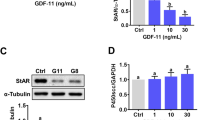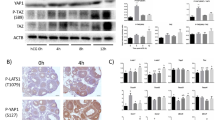Abstract
Luteinizing hormone/human chorionic gonadotropin stimulates progesterone biosynthesis in the corpus luteum by activating cyclic adenosine monophosphate/protein kinase A cascade. Recent studies have shown that cyclic adenosine monophosphate-mediated activation of protein kinase A interacts with the mammalian target of rapamycin signaling pathways. Furthermore, the use of mammalian target of rapamycin inhibitors for immunosuppression in transplant patients has shown adverse effects in reproductive functions. This study examined whether the mammalian target of rapamycin pathway plays any role in luteinizing hormone-mediated regulation of progesterone production. Human granulosa lutein cells were isolated from follicular aspirates of women undergoing in vitro fertilization. Cells were cultured for 72 h and treated with human chorionic gonadotropin (50 ng/ml) for different time periods with or without pretreatment with mammalian target of rapamycin complex 1 inhibitor, rapamycin, (20 nM) for 1 h. Expression of steroidogenic enzymes, including steroidogenic acute regulatory protein, cholesterol side chain cleavage enzyme, and 3β-hydroxysteroid dehydrogenase type 1 messenger RNA, were examined by real-time polymerase chain reaction after 6 h of human chorionic gonadotropin treatment. Expressions of phospho-ribosomal protein S6 kinase and cholesterol side chain cleavage enzyme were analyzed after 15 min and 24 h of human chorionic gonadotropin treatment, respectively. Progesterone production was analyzed by an enzyme immunoassay kit after human chorionic gonadotropin (50 ng/ml) or forskolin (10 μM) treatment for 24 h. Treatment with human chorionic gonadotropin increased the expression of downstream targets of mammalian target of rapamycin complex 1, as well as cholesterol side chain cleavage enzyme, 3β-hydroxysteroid dehydrogenase type 1 and steroidogenic acute regulatory protein messenger RNAs. These increases were inhibited by rapamycin pretreatment. Increased progesterone production in response to treatment with human chorionic gonadotropin or forskolin was also blocked by rapamycin pretreatment. Our findings support a role for mammalian target of rapamycin complex 1 in regulating steroidogenesis in human granulosa lutein cells.






Similar content being viewed by others
References
S. Azhar, M.R. Clark, K.M.J. Menon, Regulation of cyclic adenosine 3′, 5′-mono-phosphate dependent protein kinase of rat ovarian cells by luteinizing hormone and human chorionic gonadotropin. Endocr. Res. Commun. 3(2), 93–104 (1976)
M.R. Clark, K.M.J. Menon, Regulation of ovarian steroidogenesis. The disparity between 125I-labelled choriogonadotropin binding cyclic adenosine 3′,5′-monophosphate formation and progesterone synthesis in the rat ovary. Biochim. Biophys. Acta 444(1), 23–32 (1976)
M.T. Williams, J.M. Marsh, Estradiol inhibition of luteinizing hormone-stimulated progesterone synthesis in isolated bovine luteal cells. Endocrinology 103(5), 1611–1618 (1978). doi:10.1210/endo-103-5-1611
C. Stocco, C. Telleria, G. Gibori, The molecular control of corpus luteum formation, function, and regression. Endocr. Rev. 28(1), 117–149 (2007). doi:10.1210/er.2006-0022
J.T. Gwynne, J.F. Strauss 3rd, The role of lipoproteins in steroidogenesis and cholesterol metabolism in steroidogenic glands. Endocr. Rev. 3(3), 299–329 (1982). doi:10.1210/edrv-3-3-299
M.S. Brown, J.L. Goldstein, A receptor-mediated pathway for cholesterol homeostasis. Science 232(4746), 34–47 (1986)
B.J. Clark, D.M. Stocco, Expression of the steroidogenic acute regulatory (STAR) protein: a novel LH-induced mitochondrial protein required for the acute regulation of steroidogenesis in mouse Leydig tumor cells. Endocr. Res. 21(1–2), 243–257 (1995)
D. Lin, T. Sugawara, J.F. Strauss 3rd, B.J. Clark, D.M. Stocco, P. Saenger, A. Rogol, W.L. Miller, Role of steroidogenic acute regulatory protein in adrenal and gonadal steroidogenesis. Science 267(5205), 1828–1831 (1995)
P.R. Manna, M.T. Dyson, D.M. Stocco, Regulation of the steroidogenic acute regulatory protein gene expression: present and future perspectives. Mol. Hum. Reprod. 15(6), 321–333 (2009). doi:10.1093/molehr/gap025
D.K. Ghosh, W.R. Dunham, R.H. Sands, K.M.J. Menon, Regulation of cholesterol side-chain cleavage enzyme activity by gonadotropin in rat corpus luteum. Endocrinology 121(1), 21–27 (1987). doi:10.1210/endo-121-1-21
D.K. Ghosh, H. Peegel, W.R. Dunham, R.H. Sands, K.M.J. Menon, Modulation of progesterone synthesis and cytochrome P450 levels in rat luteal cells during human chorionic gonadotropin-induced desensitized state. Endocrinology 123(1), 514–522 (1988). doi:10.1210/endo-123-1-514
N. Yago, S. Ichii, Submitochondrial distribution of components of the steroid 11 beta-hydroxylase and cholesterol sidechain-cleaving enzyme systems in hog adrenal cortex. J. Biochem. 65(2), 215–224 (1969)
B. Cheng, D.K. Hsu, T. Kimura, Utilization of intramitochondrial membrane cholesterol by cytochrome P-450-dependent cholesterol side-chain cleavage reaction in bovine adrenocortical mitochondria: steroidogenic and non-steroidogenic pools of cholesterol in the mitochondrial inner membranes. Mol. Cell. Endocrinol. 40(2-3), 233–243 (1985)
T. Kimura, ACTH stimulation on cholesterol side chain cleavage activity of adrenocortical mitochondria. Transfer of the stimulus from plasma membrane to mitochondria. Mol. Cell. Biochem. 36(2), 105–122 (1981)
G.J. Hickey, R.B. Oonk, P.F. Hall, J.S. Richards, Aromatase cytochrome P450 and cholesterol side-chain cleavage cytochrome P450 in corpora lutea of pregnant rats: diverse regulation by peptide and steroid hormones. Endocrinology 125(3), 1673–1682 (1989). doi:10.1210/endo-125-3-1673
J.S. Davis, Mechanisms of hormone action: luteinizing hormone receptors and second-messenger pathways. Curr. Opin. Obstet. Gynecol. 6(3), 254–261 (1994)
X. Hou, E.W. Arvisais, J.S. Davis, Luteinizing hormone stimulates mammalian target of rapamycin signaling in bovine luteal cells via pathways independent of AKT and mitogen-activated protein kinase: modulation of glycogen synthase kinase 3 and AMP-activated protein kinase. Endocrinology 151(6), 2846–2857 (2010). doi:10.1210/en.2009-1032
R. Mejia, C. Waite, M. Ascoli, Activation of Gq/11 in the mouse corpus luteum is required for parturition. Mol. Endocrinol. 29(2), 238–246 (2015). doi:10.1210/me.2014-1324
U.M. Munshi, H. Peegel, K.M.J.Menon, Palmitoylation of the luteinizing hormone/human chorionic gonadotropin receptor regulates receptor interaction with the arrestin-mediated internalization pathway. Eur. J. Biochem. 268(6), 1631–1639 (2001)
M. Hunzicker-Dunn, E.T. Maizels, FSH signaling pathways in immature granulosa cells that regulate target gene expression: branching out from protein kinase A. Cell. Signal. 18(9), 1351–1359 (2006). doi:10.1016/j.cellsig.2006.02.011
M.E. Hunzicker-Dunn, B. Lopez-Biladeau, N.C. Law, S.E. Fiedler, D.W. Carr, E.T. Maizels, PKA and GAB2 play central roles in the FSH signaling pathway to PI3K and AKT in ovarian granulosa cells. Proc. Natl. Acad. Sci. U. S. A. 109(44), E2979–2988 (2012). doi:10.1073/pnas.1205661109
S. Das, E.T. Maizels, D. DeManno, E. St Clair, S.A. Adam, M. Hunzicker-Dunn, A stimulatory role of cyclic adenosine 3′,5′-monophosphate in follicle-stimulating hormone-activated mitogen-activated protein kinase signaling pathway in rat ovarian granulosa cells. Endocrinology 137(3), 967–974 (1996). doi:10.1210/endo.137.3.8603610
H. Alam, E.T. Maizels, Y. Park, S. Ghaey, Z.J. Feiger, N.S. Chandel, M. Hunzicker-Dunn, Follicle-stimulating hormone activation of hypoxia-inducible factor-1 by the phosphatidylinositol 3-kinase/AKT/Ras homolog enriched in brain (Rheb)/mammalian target of rapamycin (mTOR) pathway is necessary for induction of select protein markers of follicular differentiation. J. Biol. Chem. 279(19), 19431–19440 (2004). doi:10.1074/jbc.M401235200
P.P. Kayampilly, K.M.J. Menon, Follicle-stimulating hormone increases tuberin phosphorylation and mammalian target of rapamycin signaling through an extracellular signal-regulated kinase-dependent pathway in rat granulosa cells. Endocrinology 148(8), 3950–3957 (2007). doi:10.1210/en.2007-0202
M. Laplante, D.M. Sabatini, Regulation of mTORC1 and its impact on gene expression at a glance. J. Cell Sci. 126(Pt 8), 1713–1719 (2013). doi:10.1242/jcs.125773
M. Laplante, D.M. Sabatini, mTOR signaling in growth control and disease. Cell 149(2), 274–293 (2012). doi:10.1016/j.cell.2012.03.017
M. Laplante, D.M. Sabatini, mTOR signaling. Cold Spring Harb. Perspect. Biol. 4(2) (2012). doi: 10.1101/cshperspect.a011593
M. Laplante, D.M. Sabatini, mTOR signaling at a glance. J. Cell Sci. 122(Pt 20), 3589–3594 (2009). doi:10.1242/jcs.051011
D.D. Sarbassov, S.M. Ali, D.M. Sabatini, Growing roles for the mTOR pathway. Curr. Opin. Cell Biol. 17(6), 596–603 (2005). doi:10.1016/j.ceb.2005.09.009
E. Jacinto, R. Loewith, A. Schmidt, S. Lin, M.A. Ruegg, A. Hall, M.N. Hall, Mammalian TOR complex 2 controls the actin cytoskeleton and is rapamycin insensitive. Nat. Cell Biol. 6(11), 1122–1128 (2004). doi:10.1038/ncb1183
L. Gu, L. Xie, C. Zuo, Z. Ma, Y. Zhang, Y. Zhu, J. Gao, Targeting mTOR/p70S6K/glycolysis signaling pathway restores glucocorticoid sensitivity to 4E-BP1 null Burkitt Lymphoma. BMC Cancer 15, 529 (2015). doi:10.1186/s12885-015-1535-z
Y.J. Chen, P.W. Hsiao, M.T. Lee, J.I. Mason, F.C. Ke, J.J. Hwang, Interplay of PI3K and cAMP/PKA signaling, and rapamycin-hypersensitivity in TGFbeta1 enhancement of FSH-stimulated steroidogenesis in rat ovarian granulosa cells. J. Endocrinol. 192(2), 405–419 (2007). doi:10.1677/JOE-06-0076
A.K. Nair, H. Peegel, K.M.J. Menon, The role of luteinizing hormone/human chorionic gonadotropin receptor-specific mRNA binding protein in regulating receptor expression in human ovarian granulosa cells. J. Clin. Endocrinol. Metab. 91(6), 2239–2243 (2006). doi:10.1210/jc.2005-2739
W. Strober, Trypan blue exclusion test of cell viability. Curr. Protoc. Immunol. Appendix 3, Appendix 3B (2001). doi: 10.1002/0471142735.ima03bs21
L. Wang, A.K. Nair, K.M.J. Menon, Ribonucleic acid binding protein-mediated regulation of luteinizing hormone receptor expression in granulosa cells: relationship to sterol metabolism. Mol. Endocrinol. 21(9), 2233–2241 (2007). doi:10.1210/me.2007-0102
K.M.J. Menon, K.P. Gunaga, Role of cyclic AMP in reproductive processes. Fertil. Steril. 25(8), 732–750 (1974)
N. Hay, N. Sonenberg, Upstream and downstream of mTOR. Genes Dev. 18(16), 1926–1945 (2004). doi:10.1101/gad.1212704
D.R. Alessi, P. Cohen, Mechanism of activation and function of protein kinase B. Curr. Opin. Genet. Dev. 8(1), 55–62 (1998)
J. Cottom, L.M. Salvador, E.T. Maizels, S. Reierstad, Y. Park, D.W. Carr, M.A. Davare, J.W. Hell, S.S. Palmer, P. Dent, H. Kawakatsu, M. Ogata, M. Hunzicker-Dunn, Follicle-stimulating hormone activates extracellular signal-regulated kinase but not extracellular signal-regulated kinase kinase through a 100-kDa phosphotyrosine phosphatase. J. Biol. Chem. 278(9), 7167–7179 (2003). doi:10.1074/jbc.M203901200
I.J. Gonzalez-Robayna, A.E. Falender, S. Ochsner, G.L. Firestone, J.S. Richards, Follicle-Stimulating hormone (FSH) stimulates phosphorylation and activation of protein kinase B (PKB/Akt) and serum and glucocorticoid-lnduced kinase (Sgk): evidence for A kinase-independent signaling by FSH in granulosa cells. Mol. Endocrinol. 14(8), 1283–1300 (2000). doi:10.1210/mend.14.8.0500
M. Palaniappan, K.M.J. Menon, Human chorionic gonadotropin stimulates theca-interstitial cell proliferation and cell cycle regulatory proteins by a cAMP-dependent activation of AKT/mTORC1 signaling pathway. Mol. Endocrinol. 24(9), 1782–1793 (2010). doi:10.1210/me.2010-0044
M. Palaniappan, K.M.J. Menon, Luteinizing hormone/human chorionic gonadotropin-mediated activation of mTORC1 signaling is required for androgen synthesis by theca-interstitial cells. Mol. Endocrinol. 26(10), 1732–1742 (2012). doi:10.1210/me.2012-1106
S. Lee, M. Coco, S.M. Greenstein, R.S. Schechner, V.A. Tellis, D.G. Glicklich, The effect of sirolimus on sex hormone levels of male renal transplant recipients. Clin. Transplant. 19(2), 162–167 (2005). doi:10.1111/j.1399-0012.2005.00257.x
L. Fritsche, K. Budde, D. Dragun, G. Einecke, F. Diekmann, H.H. Neumayer, Testosterone concentrations and sirolimus in male renal transplant patients. Am. J. Transplant. 4(1), 130–131 (2004)
Y. Boobes, B. Bernieh, H. Saadi, M. Raafat Al Hakim, S. Abouchacra, : Gonadal dysfunction and infertility in kidney transplant patients receiving sirolimus. Int. Urol. Nephrol. 42(2), 493–498 (2010). doi:10.1007/s11255-009-9644-8
Acknowledgments
The authors wish to express appreciation to the staff at IVF facility in the University of Michigan for providing ovarian follicular aspirates. They are grateful to Sarah Block for critical reading of the manuscript and many helpful suggestions.
Author information
Authors and Affiliations
Corresponding author
Ethics declarations
Conflict of interest
The authors declare that they have no conflict of interest.
Ethical approval
Exception granted since the material used are otherwise discarded.
Additional information
Molly B. Moravek and Min Shang contributed equally to the work.
Min Shang’s present address: Department of Obstetrics and Gynecology, Beijing Friendship Hospital, Capital Medical University, Beijing, China.
Rights and permissions
About this article
Cite this article
Moravek, M.B., Shang, M., Menon, B. et al. HCG-mediated activation of mTORC1 signaling plays a crucial role in steroidogenesis in human granulosa lutein cells. Endocrine 54, 217–224 (2016). https://doi.org/10.1007/s12020-016-1065-8
Received:
Accepted:
Published:
Issue Date:
DOI: https://doi.org/10.1007/s12020-016-1065-8




